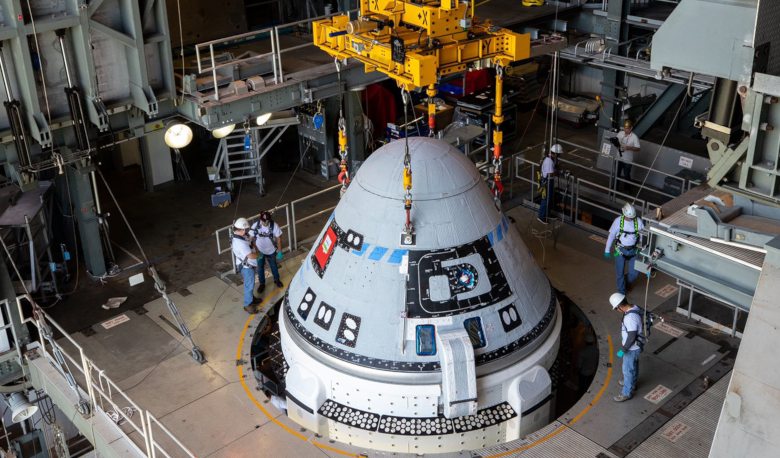Amidst a recent spat with NASA over seat prices to the International Space Station (ISS), Boeing’s Starliner crew capsule has started preparations for its first unpiloted test flight to the orbital laboratory mid-December, by leaving its factory at the Kennedy Space Center for its new home a few miles away at Cape Canaveral.
After rolling out of a former space shuttle hangar at Kennedy on a motorised payload transporter, with a top speed of 5 mph, the transporter paused outside the Starliner manufacturing building for a brief ceremony.
Boeing and NASA officials, along with employees and astronauts Mike Fincke, Chris Ferguson and Nicole Mann who are assigned to fly Starliner on its first crewed mission next year, helped commemorate the milestone in Starliner's journey.
Starliner now sits atop its ride to space, the United Launch Alliance Atlas V rocket at ULA's Vertical Integration Facility (VIF), where it awaits the Integrated Systems Test; a tip-to-tail electrical check of the 172-foot-tall Atlas V and Starliner stack to verify all elements are communicating properly.
That will clear the way for IDOLT, or Integrated Day-of-Launch Test, to rehearse all aspects of the Atlas V countdown.
The December week-long test demonstration flight will be a crucial trial for Starliner as it seeks NASA certification to fly astronauts to and from the space station.
“This is critical to our future as a nation,” said Bob Cabana, a former astronaut and current director of the Kennedy Space Center. “We’ve got to get astronauts flying on US rockets out of here on US soil and not have to rely on our Russian partners, and this is just a huge step forward.”
Relying on Soyuz vehicles to take crew to and from the ISS has been something of a bugbear for NASA and so for the past decade the US space agency has been promoting its Commercial Crew program and enlisting the help of American space firms to end their dependence on Russia.
Five years ago, Boeing and SpaceX emerged as the big winners, racking up contracts currently worth $4.3 billion and $2.5 billion, respectively, to fly six missions apiece to and from the space station.
However, in the last week, NASA’s Inspector General has criticised Boeing over a report that its Starliner seat prices cost 60 percent more than SpaceX.
The report estimated that by using the Boeing-built Starliner, NASA will end up paying about $90 million per seat to fly astronauts to and from the ISS compared to just $55 million per seat on Crew Dragon.
Boeing refuted the figure and hit back at NASA with its own statement; “We strongly disagree with the report’s conclusions about CST-100 Starliner pricing and readiness, and we owe it to the space community and the American public to share the facts the Inspector General [IG] missed,” said Jim Chilton, vice president and general manager of Boeing Space and Launch.
“Each member of the Boeing team has a personal stake in the safety, quality and integrity of what we offer our customers, and since Day One, the Starliner team has approached this program with a commitment to design, develop and launch a vehicle that we and NASA can be proud of.”
Far from being overpaid to prepare for multiple crewed missions say Boeing, “we cut lead time to launch by two-thirds and doubled the launch rate for an overall price increase of only 5 percent.”
Boeing also seemed to taunt its competitors in the report as it stated; “Starliner flies on the most reliable lifter in the business, an Atlas V modified for human spaceflight safety by people with actual experience in the domain. The spacecraft touches back down to Earth on land, not a splashdown, something Boeing considers much safer.”
Along the way, SpaceX have encountered a number of problems with their launch abort propulsion, parachutes and other systems, which has caused delays to their first crew launches by several years.
Something that has not gone unnoticed by NASA, who also appeared to criticise SpaceX too right before Elon Musk prepared to unveil the company’s new Starship rocket in September.
"I am looking forward to the SpaceX announcement tomorrow. In the meantime, Commercial Crew is years behind schedule. NASA expects to see the same level of enthusiasm focused on the investments of the American taxpayer. It's time to deliver,” wrote Jim Bridenstine, NASA’s big chief via Twitter.
Nonetheless, SpaceX have already performed the first test flight of its Crew Dragon spacecraft, when it headed to the ISS in March for a week-long stay before heading back to Earth.
The only inhabitant onboard was a life-sized mannequin called "Ripley," named after Sigourney Weaver's character in the "Alien" films.
Boeing aim to send a similar anthropometric test dummy on their test flight, but this one is called “Rosie the Astronaut” in honor of “Rosie the Riveter,” an icon of World War II honouring the contributions of women in aircraft and armament factories.
“Rosie embodies everything you would expect from her name: inspiration, strength, hope, determination and the future of human spaceflight,” Boeing said.
“Sitting in the Starliner commander’s seat, she’ll be equipped with hundreds of sensors that will return critical data to the Starliner team ahead of the first crewed flight. They’ll be especially interested in the forces she experiences through launch, ascent, re-entry and landing.”











